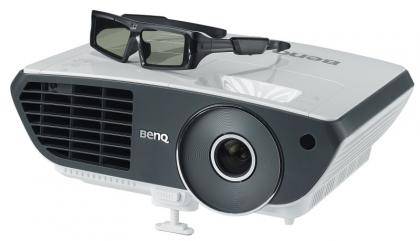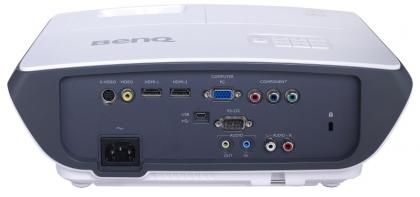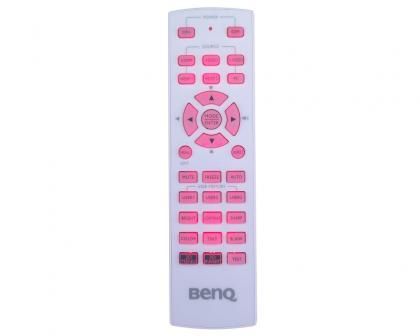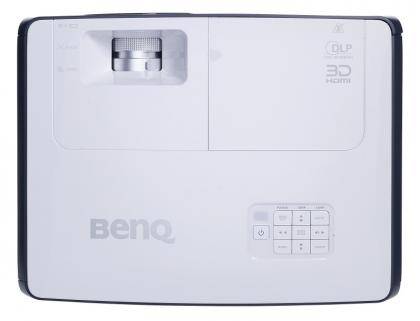If you don't have a lot of money, but still want the big screen you can get with a projector, a 720p model can still be a good choice. The BenQ W703D 1,280x720 DLP projector is incredibly cheap, making it seem like a good choice on paper.
As you might expect from a projector like this, it's a compact model that's really designed for occasional use, coming out of a cupboard when you need it. It's quite compact, so you should be fine putting it on a shelf or coffee table, but its 1.1x optical zoom is very restrictive when it comes to adjusting the size of the image.

There's also no lens shift, so you'll need to place the projector head-on to your screen if you don't want to have to resort to quality-reducing digital keystone controls. It's good to see a wall colour mode, so you can project onto a strongly coloured wall and compensate for its colour inside the projector.
Thankfully, its wide range of connections round the back makes it simple to set up. It has two HDMI inputs and single VGA, component, S-video, composite inputs at its disposal, as well as a mini-USB service port. You’ll probably want to connect it a pair of dedicated speakers to get the best sound quality, as its tiny 2W speakers are very tinny and don’t produce a lot of volume.

It comes with several preset picture modes, including Bright, Living Room, Gaming, Cinema, and 3D, but sadly none of them can be customised. We found that Living Room produced the deepest blacks and most vibrant colours, but the rest made colours appear quite drab and washed out. Blacks and darker scenes were similarly mediocre, often appearing quite grey across all areas of the screen, and we noticed a considerable amount of colour bleed on the left side of the screen as well.
Its default contrast levels were also very poor regardless of which mode we picked, but luckily there are also three customisable User modes (the third is 3D only) that can use any of the above settings as a reference. In practice, though, all you can change is the contrast, brightness and colour temperature as the rest of its options, including sharpness and tint are locked down for digital inputs.
This leaves very little scope for getting the best picture, and while we did manage to find a decent level of image quality using these basic settings, we had to sacrifice colour vibrancy in order to improve the contrast. At least the remote is a step in the right direction. It's responsive, backlit for use in the dark and we like that it gives you instant access to your three individual user picture modes.

It wasn’t just its basic menu and below average picture quality which was disappointing, as watching films also failed to leave much of an impression. As it’s a DLP-based projector, it will inevitably suffer from a slight rainbow effect due to its spinning colour wheel, but it seemed particularly bad here. It’s possible to get used to this over time, but it’s certainly worse on the W703D than other DLP projector’s we’ve tested. We also noticed the image becoming quite jerky during fast camera pans, and the image almost ground to a halt while adjusting settings in the menu.
The W703D is 3D-ready, too, but it doesn’t come with 3D glasses, so you’ll need to factor in this extra cost (£94 from www.projectorshop24.co.uk) if you’re set on having 3D. We wouldn’t recommend it, though, as watching 3D films with the glasses that came with our review sample was quite painful on the eyes.

Aside from images appearing very dim and washed out, there was a constant flicker across the screen. Unfortunately, we weren’t able to correct this, as its 3D menu settings are even more basic than its main menu options. Even worse was the fact that our glasses also had a tendency to flood the entire screen with just one shade of colour, giving a rather unintended psychedelic effect to our viewing. Needless to say, you’ll want to look elsewhere if you’re serious about 3D.
Brightness of 2,200 ANSI lumens is quite useful, as it means that you don't have to turn off all the lights to see the screen. Running costs are also reasonable, with the lamp rated to last 4,500 hours in normal mode and 6,000 hours in ECO mode. That works out at 3p and 2p per hour respectively.
The BenQ W703D is certainly very cheap, but its overall image quality is below average even for a budget projector. We recommend the Budget Buy-winning Epson EH-TW480 instead.
|
Details |
|
Price |
£415 |
|
Details |
www.benq.co.uk |
|
Rating |
** |
|
Specifications |
|
Projector technology |
DLP |
|
Lamp brightness |
2,200 ANSI lumens |
|
Lamp life |
4,500 |
|
Lamp life in economy mode |
6,000 |
|
Contrast ratio |
10,000:1 |
|
Picture |
|
Native resolution |
1,280x720 |
|
Max compressed resolution |
1,600x1,200 |
|
Aspect ratio |
16:9 |
|
Other aspect ratios |
16:10, 4:3, real |
|
Max diagonal at 7ft |
62in |
|
Throw ratio |
1.54:1 to 1.73:1 |
|
Optical zoom |
1.1x |
|
Projection distance |
1.1m to 10.2m |
|
Mirror image |
yes |
|
Invert image |
yes |
|
Lens shift horizontal |
0% |
|
Lens shift vertical |
0% |
|
HD Ready |
yes |
|
Special view modes |
bright, living room, gaming, cinema, user, 3D |
|
Inputs/Outputs |
|
VGA input |
yes |
|
DVI input |
No |
|
Sound inputs |
3.5mm |
|
Composite input |
yes |
|
S-video input |
yes |
|
HDMI input |
yes |
|
PAL support |
yes |
|
SECAM support |
yes |
|
NTSC support |
yes |
|
Audio output |
3.5mm |
|
Video output |
none |
|
Others inputs/outputs |
USB service port, RS232, DC 12V trigger |
|
Other |
|
Noise (in normal use) |
31dB(A) |
|
Size |
113x330x247mm |
|
Weight |
3.3kg |
|
Internal speakers |
yes (2W stereo) |
|
Extras |
carry bag, remote, power cable, VGA cable |
|
Remote special features |
aspect ratio, colour mode, 3D mode, input select |
|
Power consumption standby |
1W |
|
Power consumption on |
250W |
|
Lamp |
|
Lamp cost (inc VAT) |
£115 |
|
Lamp supplier |
www.projectors.co.uk |
|
Lamp cost per hour of use |
£0.03 |
|
Lamp cost per hour of use (economy) |
£0.02 |
|
Buying Information |
|
Price |
£415 |
|
Supplier |
http://www.projectorplanet.co.uk |
|
Details |
www.benq.co.uk |
Details
Specifications
Picture
Inputs/Outputs
Other
Lamp
Buying Information








